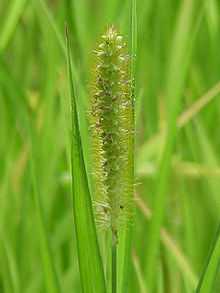Setaria pumila
| Setaria pumila | |
|---|---|
 | |
| Scientific classification | |
| Kingdom: | Plantae |
| (unranked): | Angiosperms |
| (unranked): | Monocots |
| (unranked): | Commelinids |
| Order: | Poales |
| Family: | Poaceae |
| Genus: | Setaria |
| Species: | S. pumila |
| Binomial name | |
| Setaria pumila (Poir.) Roem. & Schult. | |
| Synonyms[1] | |
| |
Setaria pumila is a species of grass known by many common names, including yellow foxtail, yellow bristle grass, pigeon grass, and cattail grass. It is native to Europe, but it is known throughout the world as a common weed. It grows in lawns, sidewalks, roadsides, cultivated fields, and many other places. This annual grass grows 20 centimeters to well over a meter in height, its mostly hairless stems ranging from green to purple-tinged in color. The leaf blades are hairless on the upper surfaces, twisting, and up to 30 centimeters long. The inflorescence is a stiff, cylindrical bundle of spikelets 2 to 15 centimeters long with short, blunt bristles. The panicle may appear yellow or yellow-tinged.
In New Zealand S. pumila can cover 20-40% of otherwise productive dairy farming pasture causing a loss in milk production.[2]
References
- ↑ "The Plant List: A Working List of All Plant Species". Retrieved 14 December 2014.
- ↑ "Weed control - Yellow bristle grass". AgResearch. Retrieved 20 April 2012.